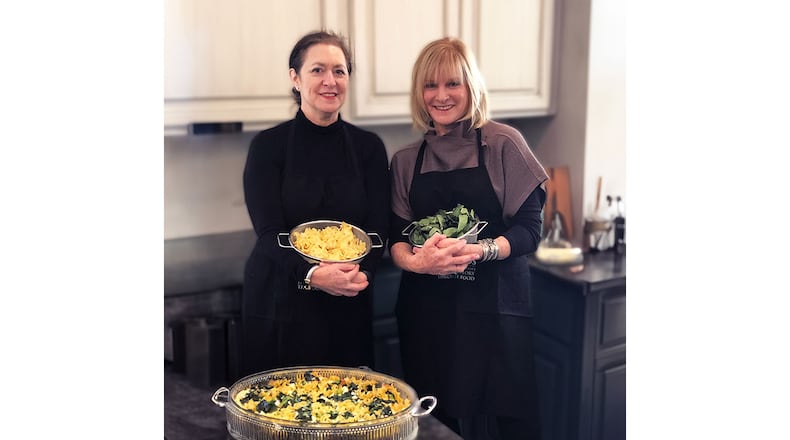“Kugels & Collards: Stories of Food, Family, and Tradition in Jewish South Carolina” (University of South Carolina Press, $36.99) by Rachel Gordin Barnett and Lyssa Kligman Harvey is a multicultural story of food and history.
Four years in the making, it’s a collection of essays, recipes and photos from 60 contributors, all of whom have called South Carolina home.
“What we created here is a sort of unintentional archive of South Carolina’s Jewish history through the food memories that are so important to its people,” said Gordin Barnett in an interview with The Atlanta Journal-Constitution. “The first Jews appear in South Carolina in the late 1690s, and by the 1800s, Charleston has the largest Jewish community in what was then the United States.”
Credit: Handout
Credit: Handout
South Carolina’s Jewish history is certainly long and deep, beginning with Sephardic Jews, who were the earliest to escape from Spain and Portugal during the Inquisition, followed by the Ashkenazi, and many waves since.
“My grandfather was a Russian immigrant,” Gordin Barnett said. “He and his brothers left Russia to escape the pogrom, and they landed in New York. But they made their way South, and they took off to these little towns in South Carolina, and became peddlers. Then, when they got a little more resources, they were able to open stores in these small towns, and that’s where I grew up.”
“I grew up in Columbia, the capital of South Carolina. But my grandfather had the exact same story,” Kligman Harvey said. “He came to America from Russia. My grandmother came from Poland, and they were sponsored by relatives who had already migrated down South. My grandparents lived in several different towns until they found their way to Columbia, where they had a grocery store and an Army-Navy store.”
Both authors say “Kugels & Collards” was a labor of love. They worked closely with the preservation advocacy group Historic Columbia of South Carolina and the Jewish Historical Society of South Carolina, where Gordin Barnett is the executive director. Fittingly, those two organizations will receive all proceeds from sales of the book.
Before the book, there was the Kugels & Collards blog, which the authors started in 2017, collecting South Carolina Jewish family stories and recipes. Since then historic markers, walking tours and oral histories have been added to the project.
“Lyssa and I, having an interest in food, thought, why don’t we talk about food memories,” Gordin Barnett remembered. “Who doesn’t have great food memories?”
“At first, when we asked people to contribute stories, they were a little hesitant,” Kligman Harvey said. “But by the time they finished writing the story, and remembered the smells and the people around the table, they thanked us for helping them recall. So one memory led to another, and one recipe led to another.”
Credit: handout
Credit: handout
The chapter, “Around the Jewish Table,” features recipes for Rosh Hashanah, and Kligman Harvey and Gordin Barnett are proud to say they cooked every one of them.
“What surprised me in gathering these stories was really how emotional people would get about their memories of being around the Jewish table,” Kligman Harvey said. “Rachel and I call it a collective unconscious of Jewish food memories. That’s what we think of as the Southern-Jewish table.”
Gordin Barnett grew up in the only Jewish family in the small town of Summerton, South Carolina. And her family employed an African American housekeeper, Ethel Mae Glover, who took care of the family and cooked all the meals.
“She learned how to keep a kosher kitchen, and she brought her Southern recipes in, and she knew how to not cook with pork,” Gordin Barnett remembered.
Fittingly, the first recipe in “Kugels & Collards” is Ethel Glover’s Collards, which she often cooked for the Gordon family.
RECIPES
These recipes from “Kugels & Collards” include an array of dishes from the Jewish table, including stuffed cabbage, chopped liver, mandelbrot and a poppy seed Bundt cake.
Credit: Forrest Clonts
Credit: Forrest Clonts
Aunt Sophie’s Stuffed Cabbage
For decades, Jewish congregations in South Carolina have shared Jewish customs and cuisine with the larger community through annual fundraising food events. The members of Columbia, South Carolina’s Tree of Life Congregation enjoy traditional Jewish dishes and baked goods at the annual celebration, “The Big Nosh.” The event offers an array of Jewish delicacies, including Aunt Sophie’s recipe for Stuffed Cabbage by Donna Stern Magaro.
For nutritional calculations, the salt included is defined as 1/16 teaspoon.
Recipes excerpted from “Kugels & Collards: Stories of Food, Family, and Tradition in Jewish South Carolina” by Rachel Gordin Barnett and Lyssa Kligman Harvey. Copyright 2023 by Rachel Gordin Barnett and Lyssa Kligman Harvey. Used by permission of the University of South Carolina Press.
Credit: Forrest Clonts
Credit: Forrest Clonts
Faye’s Chopped Liver
Faye Levinson of Columbia, South Carolina was an impressive host. Chopped liver is a traditional Jewish dish, and Faye’s incredible chopped liver is an oniony, creamy dip.
For nutritional calculations, the salt included is defined as 1/16 teaspoon.
Credit: Forrest Clonts
Credit: Forrest Clonts
Lyssa’s Jewish Star Poppy Seed Cake
Lyssa Kligman Harvey’s Star of David poppy seed cake has become a family and Columbia, South Carolina Jewish community favorite. A Star of David Nordic Ware pan makes this delicious moist cake look festive.
Credit: Forrest Clonts
Credit: Forrest Clonts
Sadye’s Mandelbrot
Sadye Krell from Charleston, South Carolina kept a kosher home. She was asked to make her mandelbrot (a traditional Jewish cookie similar to biscotti) for all simchas (joyous occasions such as births and weddings) and synagogue bake sales. Her recipe was slightly different than traditional recipes. Her secret? Half a cup of vegetable oil rather than a whole cup. Her vital ingredient was love.
Sign up for the AJC Food and Dining Newsletter
Read more stories like this by liking Atlanta Restaurant Scene on Facebook, following @ATLDiningNews on Twitter and @ajcdining on Instagram.
About the Author
The Latest
Featured








